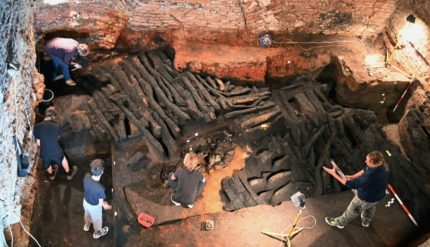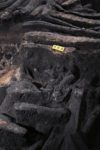 Archaeologists excavating Břeclav Castle in Moravia, Czech Republic, have discovered a section of timber and clay wall from the original castle built in the 11th century by Břetislav, Duke of Bohemia. Preliminary dating results have found the wall dates to 1041, a period when Břetislav expanded his territory with incursions into Moravia and built a network of defensive forts. Břeclav, located on the Thaya River a stone’s throw from the borders of modern-day Austria and Slovakia, was a strategically significant spot for a castle.
Archaeologists excavating Břeclav Castle in Moravia, Czech Republic, have discovered a section of timber and clay wall from the original castle built in the 11th century by Břetislav, Duke of Bohemia. Preliminary dating results have found the wall dates to 1041, a period when Břetislav expanded his territory with incursions into Moravia and built a network of defensive forts. Břeclav, located on the Thaya River a stone’s throw from the borders of modern-day Austria and Slovakia, was a strategically significant spot for a castle.
Archaeologist Miroslav Dejmal of the Archaia Brno organization, who is conducting the research emphasized the importance of the find, saying that walls dating back to the 11th century are extremely rare.
“What you see here are the remnants of a wall made of clay and wood. These are the foundations, because the upper part was obviously destroyed by a fire, as you can see from this soft charcoal.”
The original wall, which was hidden for centuries under a thick layer of clay, is estimated to have been around 8 metres high and parts of it are now being analysed. Preliminary results suggest that the wall is nearly a thousand years old and dates back to the first mention of the town in written records.
The town began as the castle. Duke Břetislav built the castle for defense of the border and as an administrative center for the region. In the 13th century the castle was acquired by Queen Constance of Hungary who added an imposing stone tower. During the Hussite Wars that followed the first Defenestration of Prague, the protestant Hussite forces were garrisoned in the castle from 1426 until the conclusion of hostilities in 1433. The market town of Břeclav, which had grown under the shadow of the castle, was destroyed during the wars of the 15th century. The townspeople fled to the castle for safety and lived to rebuild the town even closer to the castle that had saved them.
In the first half of the 16th century, Břeclav Castle was bought by the House of Žerotín. They rebuilt the castle in Renaissance style to function as a manor house but they had barely a century to enjoy it before it was confiscated by the crown after the Žerotíns were involved in an uprising. The next owner was the House of Liechtenstein who bought it in 1638. Between the wars with the Ottoman Empire and Thirty Years’ War, the Liechtensteins never really lived in the castle. Finally in the early 19th century they decided to put their own stamp on it and rebuilt the castle in the style of a romantic faux ruin.
The castle is now being rebuilt yet again. This new construction aims to return it to the Renaissance style of the Žerotín days. The discovery of the medieval wall won’t change the reconstruction plans, but it will delay them as authorities decide how best to preserve (and take advantage of) the find.
The spokesman for Břeclav City Hall, Jiří Holobrádek, says the find has generated great interest among the locals, but it is early days yet to say how and in what way the remnants of this medieval wall will be preserved.
“It is too soon to say how we will proceed. Much depends on the outcome of the expert analysis that has only just started and we will obviously heed the advice of historians and archaeologists. However, given the importance of the discovery, it would be good to find a way to present it to the public.”
 It’s going to be a tricky thing. Removing it presents major preservation challenges as the wood once exposed begins to decay. Keep it in situ will require careful planning to prevent it from being damaged by construction right above it. The archaeological team is scanning the wall and will create a 3D model of it. That will help determine how best to proceed.
It’s going to be a tricky thing. Removing it presents major preservation challenges as the wood once exposed begins to decay. Keep it in situ will require careful planning to prevent it from being damaged by construction right above it. The archaeological team is scanning the wall and will create a 3D model of it. That will help determine how best to proceed.
Looking at the shapes of the timbers, they must have put that wall up in a hurry, they used whatever wood they could find. Why, though, did they not clear it away before building a brick castle on top, there is a major crack in the brick wall on the right, and I would not be surprised if they later filled in that arch to prevent further cracking from subsidnce.